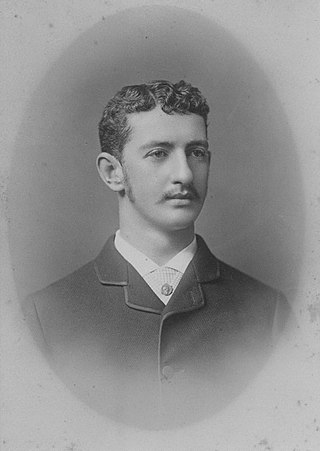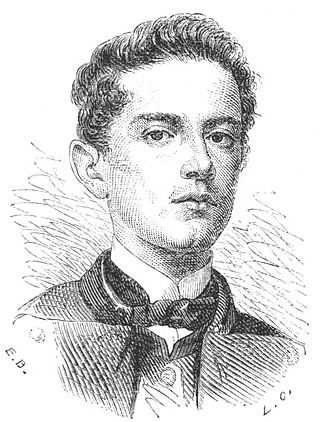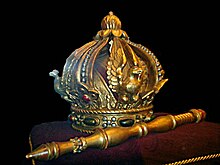
The word emperor can mean the male absolute ruler of an empire. Empress, the female equivalent, may indicate an emperor's wife, mother/grandmother, or a woman who rules in her own right and name. Emperors are generally recognized to be of the highest monarchic honor and rank, surpassing kings. In Europe, the title of Emperor has been used since the Middle Ages, considered in those times equal or almost equal in dignity to that of Pope due to the latter's position as visible head of the Church and spiritual leader of the Catholic part of Western Europe. The emperor of Japan is the only currently reigning monarch whose title is translated into English as "Emperor".

Maximilian I was an Austrian archduke who became emperor of the Second Mexican Empire from 10 April 1864 until his execution by the Mexican Republic on 19 June 1867.

Charlotte of Belgium, known by the Spanish version of her name, Carlota, was by birth a Princess of Belgium and member of the House of Wettin in the branch of Saxe-Coburg and Gotha. As the wife of Archduke Maximilian of Austria, Viceroy of Lombardy–Venetia and later Emperor of Mexico, she became Archduchess of Austria and Empress of Mexico. She was daughter, granddaughter, sister, sister in-law, cousin and wife of reigning or deposed sovereigns throughout Europe and Mexico.

Agustín de Iturbide y Green was the grandson of Agustín de Iturbide, the first emperor of independent Mexico, and his consort Ana María Huarte.

The Mexican Empire was a constitutional monarchy, the first independent government of Mexico and the only former colony of the Spanish Empire to establish a monarchy after independence. It is one of the few modern-era, independent monarchies that have existed in the Americas, along with the long-lasting Empire of Brazil (1822–1889) and the ephemeral First Empire of Haiti (1804–1806). It is typically denominated as the First Mexican Empire to distinguish it from the Second Mexican Empire of Emperor Maximilian (1864–1867). Although Mexico became a republic in 1824, it did so only after the failure of the empire under former military officer Agustín de Iturbide, who ruled as Agustín I, the sole monarch of this first empire. Monarchy was the default position for independent Mexico, called for in the political Plan of Iguala drafted by Iturbide, which united forces fighting for independence from Spain. The last Spanish viceroy signed the Treaty of Córdoba in September 1821 and the plan for monarchy in independent Mexico moved forward. Iturbide's popularity culminated in mass demonstrations on 18 May 1822, in favor of making him emperor of the new nation in the absence of any European royal agreeing to assume the throne. Congress approved the proposal and a sumptuous coronation ceremony followed in July 1822.

The Second Mexican Empire, officially the Mexican Empire, was a constitutional monarchy established in Mexico by Mexican monarchists in conjunction with the Second French Empire. The period is sometimes referred to as the Second French intervention in Mexico. French Emperor Napoleon III, with the support of the Mexican conservatives, clergy, and nobility, established a monarchist ally in the Americas intended as a restraint upon the growing power of the United States. It has been viewed as both an independent Mexican monarchy and as a client state of France. Invited to become emperor of Mexico by Mexican monarchists who had lost a bloody civil war against Mexican liberals was Austrian Archduke Maximilian, of the House of Habsburg-Lorraine, who had ancestral links to rulers of colonial Mexico. His ascension to the throne was then ratified through a fraudulent referendum. Maximilian's wife and empress consort of Mexico was the Belgian princess Charlotte of the House of Saxe-Coburg and Gotha, known in Mexico as "Carlota".

The Emperor of Mexico was the head of state and ruler of Mexico on two non-consecutive occasions in the 19th century.

The Imperial Crown of Austria is a crown formerly in use by the monarchs of the Habsburg monarchy. The crown was originally made in 1602 in Prague by Jan Vermeyen as the personal crown of Holy Roman Emperor Rudolf II, and therefore is also known as the Crown of Emperor Rudolf II. The crown was used as a private crown of the Holy Roman Emperors and Kings of Hungary and Bohemia from the House of Habsburg. In 1804 it became the official crown of the newly constituted Austrian Empire. After 1867 it remained the imperial crown of the Cisleithanian part of the Austro-Hungarian Empire until 1918.

There were three Imperial Orders of the Mexican Empire, which were Orders of chivalry created to reward Heads of state and prominent people during the two periods of the Mexican Empire—the Imperial Order of Guadalupe, the Imperial Order of the Mexican Eagle, and the Imperial Order of Saint Charles.

Salvador Agustín Francisco de Paula de Iturbide y Marzán was the grandson of Agustín de Iturbide, the first emperor of independent Mexico, and his wife Empress Ana María. He became the adopted son, along with his cousin Agustín de Iturbide y Green, of Mexico's only other imperial couple—Emperor Maximilian I and Empress Carlota.

Salvador María de Iturbide y Huarte was the eighth child of Agustín I of Mexico and Empress Ana Maria Huarte. He was married in 1845 to Doña María del Rosario de Marzán y Guisasola. His descendants, through his son Salvador de Iturbide y de Marzán, are the current pretenders to the Mexican Throne. He was in the Secretary Mexican Legation in Washington, D.C. in 1849.

Agustín Jerónimo de Iturbide y Huarte was the eldest son of the first Emperor of Mexico, Agustín I of Mexico. He was the heir apparent to the First Mexican Empire and a member of the Imperial House of Iturbide. Later in life, he served as a military officer in South America and also worked as a diplomat for the United Mexican States at the Mexican embassy in the United States and in London, after his military career had ended in South America.

The House of Iturbide is a former Imperial House of Mexico. It was founded by the Sovereign Mexican Constituent Congress on 22 June 1822 when the newly independent Mexican congress confirmed Agustín I's title of Constitutional Emperor of Mexico. He was baptized with the names of Saints Cosmas and Damian at the cathedral there. The last name Iturbide was originally from the Basque Country, Spain. Emperor Agustín abdicated and lived in exile with the prohibition on returning to Mexico. Despite that ban, he returned, was captured, and executed. Grandchildren of Emperor Agustín were adopted by Maximilian I of Mexico (1864-67), who had no biological children, and granted some status in the empheral Second Mexican Empire.

Ana María Josefa Ramona Juana Nepomucena Marcelina Huarte y Muñiz was the first Empress of Mexico. Noted for her beauty, grace and education, she married Agustín de Iturbide who ruled briefly as Emperor in 1822-23, before being exiled by the short-lived provisional government. Tempted back to Mexico to regain power, he was arrested and executed. The Empress lived out her widowhood mostly in the United States.

Coronations in the Americas were previously held by multiple countries on both continents, with the majority occurring in Latin America. They were held by endemic constitutional monarchies with their own resident monarch. There are no longer any endemic American monarchies.
Prince de Iturbide was the title originally created as Princess of Iturbide on June 22, 1822, by the Mexican Constituent Congress, to be granted to the older sister of Emperor Agustín de Iturbide. Upon the arrival of Maximilian of Habsburg, he again decreed the titles of Prince and Princess of Iturbide for the daughter who was still alive and the two grandchildren of Agustín de Iturbide.

The Regency of the Mexican Empire was a period of transition in the history of the Mexican monarchy in the absence of the Emperor of Mexico and presided by a president of the same during the First Mexican Empire (1821–1823) and the Second Mexican Empire (1863–1867). The regency is the government of a State during the minor age, absence or incapacity of its legitimate prince.

Ángel María José Ignacio Francisco Xavier de Iturbide y Huarte was the second son of Agustín de Iturbide and Ana María Huarte who received the title of Mexican Prince during the First Mexican Empire by the Constituent Congress.
The First Mexican Empire, established in 1821, with Agustín de Iturbide proclaimed as Emperor in 1822, was abolished in 1823.

The Imperial Order of the Mexican Eagle was an Order of Chivalry created by emperor Maximiliano I of Mexico during the Second Mexican Empire on January 1st of 1865. It was one of three Mexican Imperial Orders. It survives partly in name as the Order of the Aztec Eagle.






























